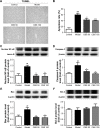Hepatoprotective effect of calculus bovis sativus on nonalcoholic fatty liver disease in mice by inhibiting oxidative stress and apoptosis of hepatocytes
- PMID: 29255346
- PMCID: PMC5723121
- DOI: 10.2147/DDDT.S150187
Hepatoprotective effect of calculus bovis sativus on nonalcoholic fatty liver disease in mice by inhibiting oxidative stress and apoptosis of hepatocytes
Abstract
Calculus bovis (CB, niu-huang) is a high-class therapeutic drug that is often used in traditional Chinese medicine. CB helps to eliminate heat and toxic components, and prevents the accumulation of phlegm and blood stasis in the liver. In Asian countries, CB Sativus (CBS), an ideal substitute for natural CB, is presently extensively used for long-term treatment of chronic liver diseases. The present study aimed to evaluate the effects and potential mechanism(s) of action of CBS on mice with fructose-induced nonalcoholic fatty liver disease (NAFLD). The NAFLD model was established in C57BL/6 mice by exclusively feeding fluids containing 30% fructose for 8 consecutive weeks. After these 8 weeks, mice were given CBS (50 mg/kg/day or 100 mg/kg/day) for 2 consecutive weeks. Treatment with CBS reversed the fructose-induced impaired glucose tolerance. Compared with the model group, in which mice received 8 weeks of high-fructose diet and 2 weeks of 0.5% sodium carboxymethyl cellulose, CBS treatment significantly decreased the levels of fasting serum glucose, fasting insulin, triglyceride, and total cholesterol, and increased levels of high-density lipoprotein-cholesterol. CBS treatment also significantly decreased the levels of triglyceride, total cholesterol, and free fatty acid in the liver. The activity of superoxide dismutase in the liver was increased after treatment with CBS, however, levels of malondialdehyde and reactive oxygen species decreased. Histopathological examination showed that liver steatosis and injury were significantly reduced in CBS-treated mice. The expression of fatty acid synthase, nuclear factor kappa-light-chain-enhancer of activated B cells, Cysteinyl aspartate-specific proteinase-3, and synonyms B-cell leukemia/lymphoma-2 gene-associated X protein were downregulated after treatment with CBS, whereas the expression of nuclear factor erythroid-2-related factor 2 was upregulated. In conclusion, CBS treatment exerted therapeutic effects in the liver of mice with NAFLD, which may be associated with amelioration of metabolic disorders, enhanced antioxidant effects, and alleviation of apoptosis.
Keywords: antioxidant; fructose; lipid metabolism; liver.
Conflict of interest statement
Disclosure The authors report no conflicts of interest in this work.
Figures









Similar articles
-
[Mechanism of Calculus Bovis Sativus in inhibiting hepatocyte lipid deposition based on serum pharmacology].Zhongguo Zhong Yao Za Zhi. 2019 Sep;44(17):3780-3785. doi: 10.19540/j.cnki.cjcmm.20190416.402. Zhongguo Zhong Yao Za Zhi. 2019. PMID: 31602953 Chinese.
-
Li-Gan-Shi-Liu-Ba-Wei-San improves non-alcoholic fatty liver disease through enhancing lipid oxidation and alleviating oxidation stress.J Ethnopharmacol. 2015 Dec 24;176:499-507. doi: 10.1016/j.jep.2015.11.019. Epub 2015 Nov 10. J Ethnopharmacol. 2015. PMID: 26571089
-
Amelioration of nonalcoholic fatty liver disease by swertiamarin in fructose-fed mice.Phytomedicine. 2019 Jun;59:152782. doi: 10.1016/j.phymed.2018.12.005. Epub 2018 Dec 10. Phytomedicine. 2019. PMID: 31005808
-
Traditional Chinese herbal extracts inducing autophagy as a novel approach in therapy of nonalcoholic fatty liver disease.World J Gastroenterol. 2017 Mar 21;23(11):1964-1973. doi: 10.3748/wjg.v23.i11.1964. World J Gastroenterol. 2017. PMID: 28373762 Free PMC article. Review.
-
Non-Alcoholic Fatty Liver Disease.Adv Exp Med Biol. 2017;960:443-467. doi: 10.1007/978-3-319-48382-5_19. Adv Exp Med Biol. 2017. PMID: 28585211 Review.
Cited by
-
Shexiang Tongxin Dropping Pill Improves Stable Angina Patients with Phlegm-Heat and Blood-Stasis Syndrome: A Multicenter, Randomized, Double-Blind, Placebo-Controlled Trial.Chin J Integr Med. 2025 Aug;31(8):685-693. doi: 10.1007/s11655-025-4014-7. Epub 2025 Jun 13. Chin J Integr Med. 2025. PMID: 40512367 Clinical Trial.
-
Liraglutide reduces hepatic glucolipotoxicity‑induced liver cell apoptosis through NRF2 signaling in Zucker diabetic fatty rats.Mol Med Rep. 2018 Jun;17(6):8316-8324. doi: 10.3892/mmr.2018.8919. Epub 2018 Apr 23. Mol Med Rep. 2018. PMID: 29693190 Free PMC article.
-
Harnessing the power of Calculus bovis: Anti-cancer properties and Wnt pathway modulation in hepatocellular carcinoma.World J Gastroenterol. 2024 Nov 7;30(41):4496-4502. doi: 10.3748/wjg.v30.i41.4496. World J Gastroenterol. 2024. PMID: 39534422 Free PMC article.
-
Calculus Bovis Sativus Improves Bile Acid Homeostasis via Farnesoid X Receptor-Mediated Signaling in Rats With Estrogen-Induced Cholestasis.Front Pharmacol. 2019 Feb 1;10:48. doi: 10.3389/fphar.2019.00048. eCollection 2019. Front Pharmacol. 2019. PMID: 30774596 Free PMC article.
-
Pien Tze Huang (PZH) as a Multifunction Medicinal Agent in Traditional Chinese Medicine (TCM): a review on cellular, molecular and physiological mechanisms.Cancer Cell Int. 2021 Mar 3;21(1):146. doi: 10.1186/s12935-021-01785-3. Cancer Cell Int. 2021. PMID: 33658028 Free PMC article. Review.
References
-
- Loomba R, Sanyal AJ. The global NAFLD epidemic. Nat Rev Gastroenterol Hepatol. 2013;10(11):686–690. - PubMed
-
- Vernon G, Baranova A, Younossi ZM. Systematic review: the epidemiology and natural history of non-alcoholic fatty liver disease and non-alcoholic steatohepatitis in adults. Aliment Pharmacol Ther. 2011;34(3):274–285. - PubMed
-
- de Ruyter JC, Olthof MR, Seidell JC, Katan MB. A trial of sugar-free or sugar-sweetened beverages and body weight in children. N Engl J Med. 2012;367(15):1397–1406. - PubMed
MeSH terms
Substances
LinkOut - more resources
Full Text Sources
Other Literature Sources
Medical

